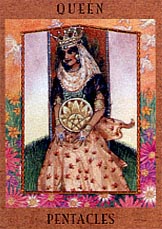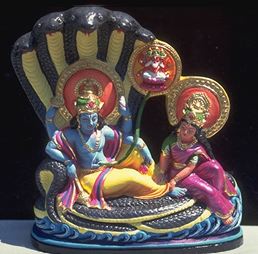
| Ahalya, Lady Wisdom | Anumati, Lady Who Favors | Devi, Goddess |
| Durga, Lady Destruction | Ganga, Cleansing Stream | Kali, Lady Black Time |
| Lakshmi, Lady Wealth | Lalita, The Playful Child | Parvati, Lady Carnality |
| Radha, Infinite Love | Sarasvati, Lady of Knowledge | Shakti, Cosmic Energy |
| Sita, Faithful Wife | Usas, Lady of the Dawn | Yakshi, Spirits of Air and Tree |
Hinduism is in vogue in the West: it's far-out, spiritual, anti-materialism, sexual, ascetic and--best of all--not our parents' religion. These, at least, are the strains inherited by the West; but they are only bits and pieces, often taken out of context, and so misunderstood and/or misused. The sexual aspect of Hinduism, for instance, known as Tantrism or Tantric Yoga, is greatly misunderstood. It is not a free-for-all, religious permission to engage in orgies, anytime, anywhere. Tantrism is actually a deeply spiritual path, which seeks union with the Divine; the spiritual and sexual powers of women are considered indispensible towards this end. The form of Divinity generally worshipped in Tantrism is Kali, Goddess of Creation, Destruction, Time and Death. She is often called simply Mother. (Tantrism is also practiced by some Buddhists, especially those of Tibet; see Himalayan Goddesses.)
Hinduism is an ancient faith, formed by the amalgamation of the matriarchal Goddess faith of the Dravidians and the patriarchal warrior faith of the Aryans. As in Greece, many of the sky, fire and war Gods of the Aryans married the Goddesses of India. As Hinduism evolved over thousands of years, it developed a theology both esoteric and exoteric, which provided for both the spiritual and practical needs of its adherents. Its central tenet is the unification of the soul with the Ultimate Reality. All Gods and Goddesses are seen as aspects of Ultimate Reality, teachers on the path to union.
Goddesses perform a vital role in Hinduism. Some are Matrikyas, or "Mothers." Each village has its pantheon of guardian Matrikyas. Some Goddesses are providers of comfort and enlightenment. Many have been born into human form: in Hinduism, Deities and humans and even animals are all forms of the same energy, and intermingle and interchange freely. Thus, Gods can die; many of Hinduism's great epics center around a God and Goddess, each born into human form, seeking out the other and thus finding completion. Most importantly, however, Goddesses are Shaktis; that is, they are animating energy. Each God has His Shakti, His female Other, His female Self, His female Half. Without His energizing, creative Shakti, the God would be inanimate, motionless, powerless, mind without activity. Without Her God Self, the Shakti would remain energy only, without purpose, without direction, without mind. The Shakti often takes the form of the God's wife; thus, Lakshmi and Vishnu. And so Energy and Mind, the two primal creative principles, are united.
Unfortunately, over the millenia, Mind has taken precedence over Energy. Mind has been associated with the purely spiritual, with the male, while Energy has been associated with matter, with the female. This dichotomy is best expressed by the caste system. The caste system is of political, economic and religious origin. Politically, it arose out of the ancient invasions, a means of ensuring the "racial purity" of the invading Aryans. Economically, it was a means of differentiating between greater and lesser occupations, much as the Celts listed Bard, Smith and Druid as the three greatest callings. Religiously, reincarnation and caste were intertwined; as one gains enlightenment, one is born into higher and more priestly castes, the better to devote oneself to meditation and study.The caste system quickly became a means of economic and political oppression, and it was partly in response to this that Buddhism was founded: officially, Buddhism rejects the caste system as one of many illusions of the physical world. In 1947, the newly-independent nation of India declared the caste system unconstitutional. Unofficially, it is still extant, and people still advertise in the personals for spouses by caste.
Back to Introduction
Back to Hindu Goddesses
Back to Goddesses
Ahalya, Lady Wisdom
 |
This myth is an excellent example of patriarchal versus matriarchal values. It may also recount, in the obscure language of myth, the ancient Aryan invasions. |
QUEEN OF PENTACLES from ART AND WORDS ©Kris Waldherr
Back to Hindu Goddesses
Anumati, Lady Who Favors
| Her name means "Divine Favor." She is a Moon Goddess. Many Hindu Goddesses are worshipped as givers of wealth, intelligence, prosperity, children, and spiritual enlightenment. Anumati is one such Goddess. |
Back to Hindu Goddesses
Devi, The Goddess
| Her name means, literally, "Goddess." She is the sum total of all existence; all derives from Her and all ultimately returns to Her. The Goddesses here profiled are but some of Her infinite number of aspects. |
Back to Hindu Goddesses
Durga, Lady Destruction
DURGA-DEVI ©JBL
Back to Hindu Goddesses
Ganga, Cleansing Stream
| The Ganges is the Holy River of Hinduism. Bathing in its waters cleanses one of all sins. The Ganges Herself, however, has been terribly polluted by the factories along Her banks. Environmentalists are fighting to restore Her physical purity. |
Back to Hindu Goddesses
Kali, Lady Black Time
| Kali is the most well-known and least-understood of the Hindu Goddesses. An aspect of Devi, She is often portrayed as a blood-thirsty, barbaric Goddess by those who do not understand Her. |
Back to Hindu Goddesses
Lakshmi, Lady Wealth
 |
She is the Goddess of Prosperity and Beauty, the wife of Vishnu. She is said to have arisen from the churning of the primal milk ocean. Sita and Radha are two of Her incarnations, profiled below. |
LAXMI-VISHNU ©JBL
Back to Hindu Goddesses
Lalita, The Playful Child
| Lalita is a woman-child Goddess. She delights in all play and pleasure, both child-like and sexual. The universe is a great toy to Her, created for Her enjoyment. |
Back to Hindu Goddesses
Parvati, Lady Carnality
| She is passionate sexuality. Parvati is the wife of Shiva, and ruler of all the elves and spirits of the earth. |
Back to Hindu Goddesses
Radha, Infinite Love
| Her name means "Beloved One." In Hindu mythology, She is a milkmaid, the beloved of Krisha. She is an incarnation of Lakshmi, he an incarnation of Vishnu. Throughout Hindu mythology, spousal Goddesses and Gods take on mortality and reunite in human form. |
Back to Hindu Goddesses
Sarasvati, Lady of Knowledge
 |
Her name means "The Flowing One." She is the personification of the Sarasvati River in north-western India. She is the Goddess of Knowledge, Speech and the Arts. |
SARASVATI ©JBL
Back to Hindu Goddesses
Shakti, Cosmic Energy
| Shakti is a concept difficult for many Westerners to comprehend, unfortunately. Each God in Hinduism has His Shakti, the very energy of existence. Without His Shakti, the God would be mind without life, without movement, without creativity. Shakti is active, creative energy, while the God is mind (sometimes described as passive energy). Each Goddess profiled here is the Shakti of a God. Quantum physicists seem to have an easier time with this.... |
Back to Hindu Goddesses
Sita, Faithful Wife
| Sita is an ancient Goddess of the Fields adopted into Hindu folk-mythology. She is an incarnation of Lakshmi, the wife of Rama (who is, in turn, an incarnation of Vishnu). The tale told here is my re-interpretation of a famous scene from the RAMAYANA. |
Back to Hindu Goddesses
Usas, Lady of the Dawn
| Usas is the Goddess of the Dawn. She remains eternally young while men grow old. |
Back to Hindu Goddesses
Yakshi, Spirits of Air and Tree
| The Yakshi (singular Yakshini), inhabit the sacred tree of every village. Their male counterparts are the Yaksas. They are similar to the Nymphae (Graeco-Roman section). |
Back to Hindu Goddesses
Back to Introduction
Back to Himalayan Goddesses
Back to Goddesses